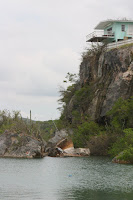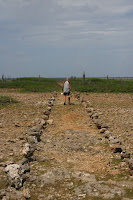Well, Cheryl left you with us leaving Santa Martha Bay with Rob on board and heading for Spaanse Waters. We had struggled with whether we should leave or not because the weather forecast was for lots of rain and some squalls. They were forecasting only minor increase in winds within the squalls so we weighed that against the need to get Rob to a more accessable place for the airport and our need to clear customs and immigration so that we could leave for Antigua, we decided to go for it. As they had promised we could see lots of squalls forming out to sea and it wasn't long before we hit the first one. We had decided not to put up the main sail for reasons of safety due to the weather. Squalls can hit fast and hard so we thought if we can get enough speed out of our foresail to get to Spaanse Water before dark that is what we would do. The sail was for the most part good although we motor sailed with the foresail so that we wouldn't have to use the main. Rob got a chance to "drive" the boat and although he admitted he is a motorboat kind of guy, he handled the boat well. When we weren't in squalls the skies were clear and blue and it was quite pleasant.
A Video of Rob at the Wheel
We got past Willemstad after being kept out farther than we wanted to be by a tanker that was in the way. Although we eventually established that it was stationary, it was difficult to tell that until we got quite close and the last thing you ever want to do is to cross the bow of a tanker or cargo ship. Their speed is deceptive and they don't have very good brakes!!!
By this time we were about 1 1/2 hours from the Spaanse Water entrance and were sure we would be there before sunset. Of course, then the sailing Gods got together for a talk and decided that they would have some fun. We were approaching the widest squall we had seen that day. Ordinally you can see both sides of a squall and from that judge it's depth. Squalls don't last long, but as I said they can be fast and furious. The ones we had hit had not been too bad so although we couldn't see the width of the one ahead of us due to it's size, we thought the winds would be about the same. Just in case, we headed up into the wind so that the wind would not be affecting our sails and we were being pushed by the motor. Now for the experience. Just before we got to the rain part of the squall, we were hit - from the side - by the heaviest blast of wind that Mystic Journey has experienced since we became owners.
Scary part - even with only the foresail up, that blast of wind drove us over on the starboard side so that the mast hit the water. It held us down for what I now believe was about 5 seconds. Not long but under those conditions a lifetime. I must say that not for a moment did I consider that Mystic Journey would not stand herself back up again and that is what happened. Of course then she tried to lay herself down the other way but only went down to about a 45 degree angle. Meanwhile the rain had hit to severly limit our visibility and we know we had to get the foresail down so that we could be strictly engine driven. The Gods weren't finished - at that point the engine alarm buzzer began to sound. I glanced at the engine instruments and thought I saw that the heat indicator was off the scale. Of course if the engine overheated, it would likely seize so I flipped the engine off. In the meantime we continued to take the foresail down as the winds and squall chops from the wind, plus the swells that had been there all allong were tossing us all over the place. Cheryl handled the stress beautifully.
I need to mention too that after the boat laid down, the first thing I thought of was Rob below decks. I looked down and could see him on the salon floor but he seemed to be hanging on so we did what had to be done to stabilize the boat. After the foresail was in or course we had not power from any source, wind or motor so I went down to check the belts on the engine to see if a fan belt had broken causing the overheat. At the same time I talked to Rob to make sure he was okay. Even though he said he as alright, I still worried that he was just trying to keep us from being distracted from handling the boat but I took him at his word and after I found the belts were intact, I went back up and re-started the engine. It didn't overheat and looking back I am not sure that it had before, but Cheryl offered a good possibility. When we were on our side, the seacock that brings in the seawater to cool the engine was out of the water. The alarm may have been to notify us of this.
Whatever the case, the motor functioned fine, the squall eventually passed, we re-established our course and continued towards Spaanse Water. When the rain passed, we saw that we had been driven back to a point off Willemstad and were now about 2 hours from the entrance. To finish this saga - we did hit one more squall before reaching safe haven although it was minor. We made it through the entrance chanel before sunset and then anchored in the dark but in an area where there were no other boats so it was fairly simple.
It was a real pleasure to settle in for the night in water that didn't rock us around even though the wind continued to stay quite strong all night. The next blog we will hopefully bring us up to date and by the time you read it we will be on the way to Antigua - hopefully!!!
.JPG)

.JPG)
.JPG)




















.JPG)












.JPG)
.JPG)
.JPG)










